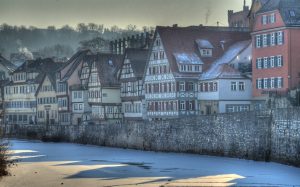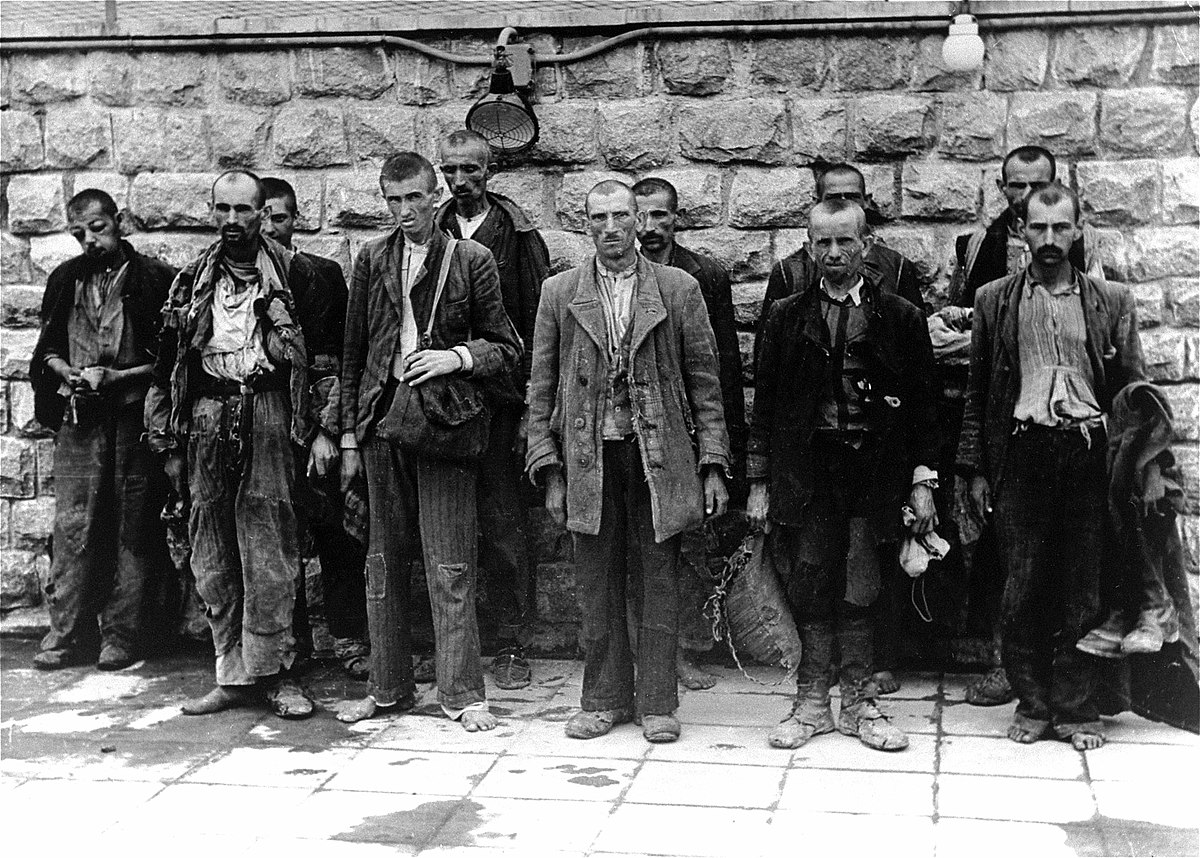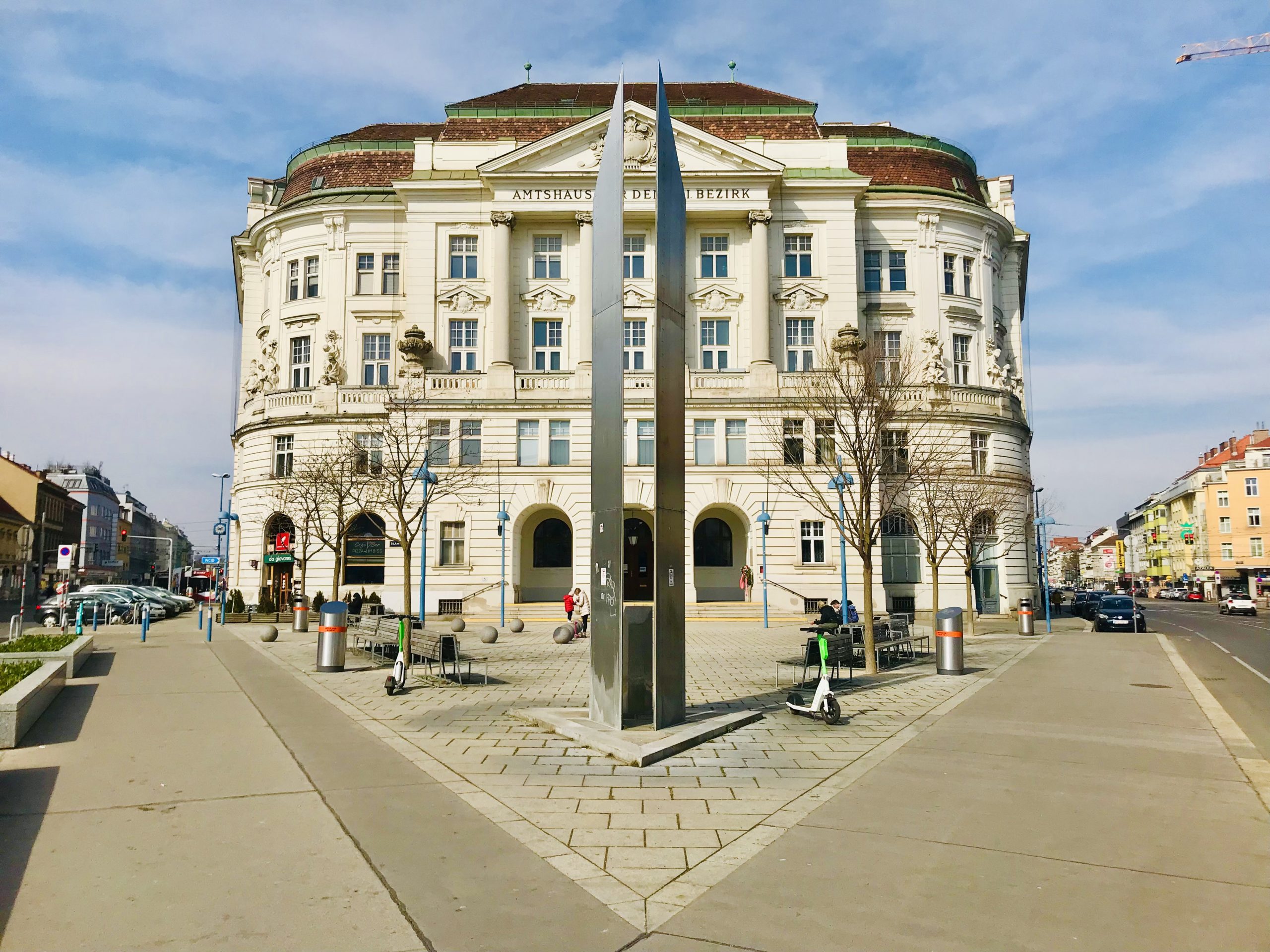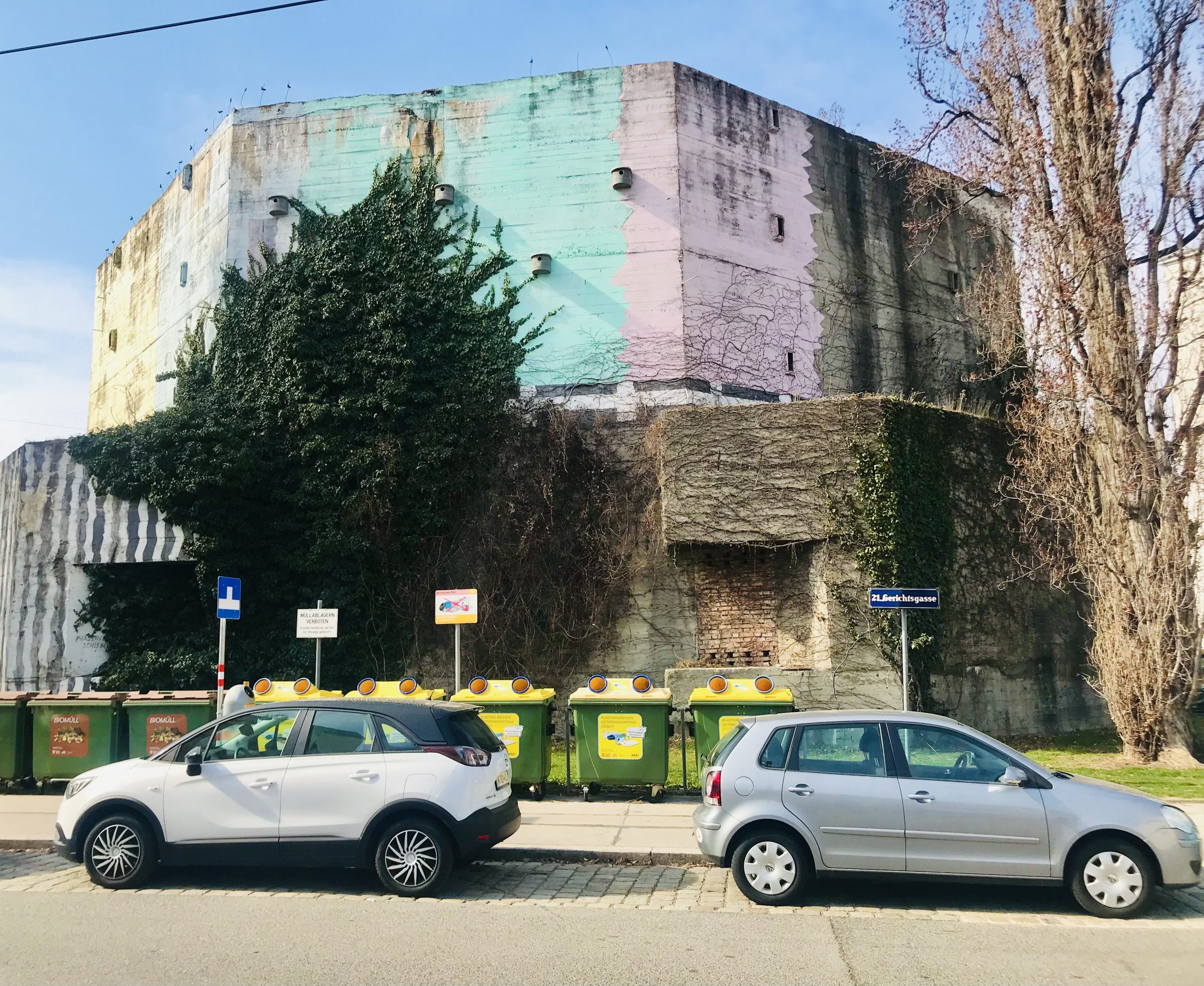
SCHWÄBISCH HALL IS A MEDIEVAL TIME CAPSULE OF ANCIENT LANES, SOARING MASSIVE TIMBERED HOUSES, AND COVERED BRIDGES, STRAIGHT OUT OF A BROTHERS GRIMM FAIRY TALE
Table of Contents
- 1 SCHWÄBISCH HALL IS A MEDIEVAL TIME CAPSULE OF ANCIENT LANES, SOARING MASSIVE TIMBERED HOUSES, AND COVERED BRIDGES, STRAIGHT OUT OF A BROTHERS GRIMM FAIRY TALE
- 2 A BRIEF HISTORY
- 3 GUIDE TO THE TOP RATED THINGS TO DO IN THE ALTSTADT (OLD TOWN) THAT DEFINE SCHWABISCH HALL
- 4 OUR EXPERIENCE IN SCHWÄBISCH HALL
- 5 PRO TIPS AND OTHER THINGS TO DO WHEN VISITING SCHWÄBISCH HALL
- 6 OTHER COOL THINGS TO DO NEAR SCHWABISCH HALL
- 7 NEAR THIS PLACE
- 8 BEST PLACES TO STAY
- 9
If you could visit just one place in Baden-Württemberg, where might it be? Heidelberg? Stuttgart? The Black Forest? Few would pick Schwäbisch Hall with its rural location near the Bavarian border. Yet, this medieval time capsule of higgledy-piggledy lanes, soaring half-timbered houses built high on the riches of salt, and covered bridges that criss-cross the Kocher River is pure Brothers Grimm stuff.” These are bold statements indeed, but specifically the reasons we love this very much out of the way gem. There are so many things to see and do in Schwäbisch Hall. Never heard of Schwäbisch Hall? Read on!
A BRIEF HISTORY
WHITE GOLD
First documented in 1063, Schwäbisch Hall has always been a prosperous salt town. For centuries, the salters here produced the “white gold of the Middle Ages”. So much so that the name “Hall” is likely derived from a German expression meaning “drying something by heating it.” This is undoubtedly a reference to the open-pan salt making methods employed in Schwäbisch Hall until 1925 when the salt industry dried up (no pun intended). As early as the 5th century BC, the Celts were producing salt from brine in Schwäbisch Hall.
IMPERIAL MINT
In 1204, Schwäbisch Hall officially earned the right to become a town. During this period, Schwäbisch Hall was ruled by the Hohenstaufen family. Prosperity soon found its way to Schwäbisch Hall. In addition to salt production, Holy Roman Emperor Frederick I designated the town the home of the imperial mint. The town soon started coining Heller, a German coin valued at half a pfennig. Heller took its name from the town of Hall am Kocher (today known as Schwäbisch Hall).
EXPANSION
After the Hohenstaufen family, Schwäbisch Hall went through a period of turbulence as various noble families sought to acquire the town. Finally, in 1280 the Habsburg emperor Rudolph I flexed his muscles and made Schwäbisch Hall a self-ruling Free Imperial City of the Holy Roman Empire. During the 14th to 16th centuries, Schwäbisch Hall grew in size as the town expanded its city limits. Schwäbisch Hall would soon acquire territory in the surrounding area from noble families and the neighboring Comberg monastery.
MARTIN LUTHER
The Benedictine monks of the Comcast monastery were of noble birth. As such, their buildings were ornate and beautiful. The wealth of this era can still be seen today in gothic buildings such as St. Michael’s Church with its impressive stairway. The early 1500s brought Martin Luther and the Protestant Reformation. Schwäbisch Hall was an early member of the Protestant Reformation and quickly the churches and schools of the town began to adopt the Lutheran traditions.
FROM FEAST TO FAMINE
During medieval times, Schwäbisch Hall was a walled city with 55 lookout towers. It was surrounded by a wide moat as protection against neighboring landowners. Although it was never besieged, Schwäbisch Hall suffered immensely during the Thirty Years’ War from 1618 to 1648. The town was forced to pay enormous sums of money to the Swedish, French and Imperial armies. Unfortunately, in exchange for these generous donations, the town and surrounding areas were heavily plundered.
FROM FAMINE TO PLAGUE
From 1634 to 1638, 20 percent of Schwäbisch Hall’s population would die from hunger and the bubonic plague. The tragedy of war combined with the black death left the town in despair. Schwäbisch Hall found itself impoverished and economically ruined. If war and disease weren’t bad enough, devastating fires in 1680 and 1728 consumed many of the wooden houses of the town. Schwäbisch Hall was reborn with new buildings constructed in the baroque style.
NAPOLEON
In 1801, Napoleon and his armies conquered Central Europe and brought Schwäbisch Hall’s history as a self-ruling Free Imperial City to an end. An unfortunate outcome of Napoleon’s occupation, Schwäbisch Hall would lose both its territory and political independence. The town’s lucrative salt mines were turned over to the state. While other neighboring towns embraced the Industrial Revolution, Schwäbisch Hall did not. As a result, throughout the 1800s the economy stagnated. Only salt production and the growing wine trade would bring Schwäbisch Hall back from the brink.
WW2 AND THE COLD WAR
Tragically on 9 November 1938, Nazis burned down the local synagogue and destroyed Jewish storefronts and homes during Kristallnacht (Night of Broken Glass). Ultimately, 40 Jewish citizens of Schwäbisch Hall would perish during the Holocaust. To honor their stolen lives, Stones of Remembrance have been placed outside their former residences. In 1944, the Nazis built a concentration camp next to the Hall-Hessental train station. The camp housed slaves who worked at the Luftwaffe airbase on the outskirts of Schwäbisch Hall. Later renamed Dolan Barracks by the Americans, during WW2 this airfield housed Messerschmitt Me 262 jet fighters.
On 23 February 1945, 24 American Liberator bombers dropped their payloads on Schwäbisch Hall destroying the Hall-Hessental train station. Days later on 25 February, 53 civilians were killed during an Allied bombing raid. Although incendiary bombs would reduce the Rathaus (Town Hall) to rubble, the old town and its spectacular medieval homes miraculously survived WW2 with minimal damage.
On 17 April 1945, U.S. troops entered Schwäbisch Hall and faced limited resistance. Until the end of the Cold War, the Schwäbisch Hall Army Air Field was home to several American aviation and artillery units. The United States turned over both military bases to the German government in 1993.
GUIDE TO THE TOP RATED THINGS TO DO IN THE ALTSTADT (OLD TOWN) THAT DEFINE SCHWABISCH HALL
Schwäbisch Hall has a healthy mix of preserved medieval buildings including fachwerkhausen or half-timber framed homes, Gothic and Baroque styles. The old town is divided into several sections: The Marktplatz, St. Michael’s Church, Obere Herrngasse, Im Haal, and the islands and pathways along the Kocher River. As there are numerous things to see and do, each section of Schwabisch Hall is well worth exploring.
Our guide lists the best things to see and do in each section of Schwabisch Hall. Click on the Google Map address links to pull up directions or better yet, have an adventure and find them on your own. Our Guide has additional research not included in the brochures at the Schwabisch Hall Tourist Information Center.
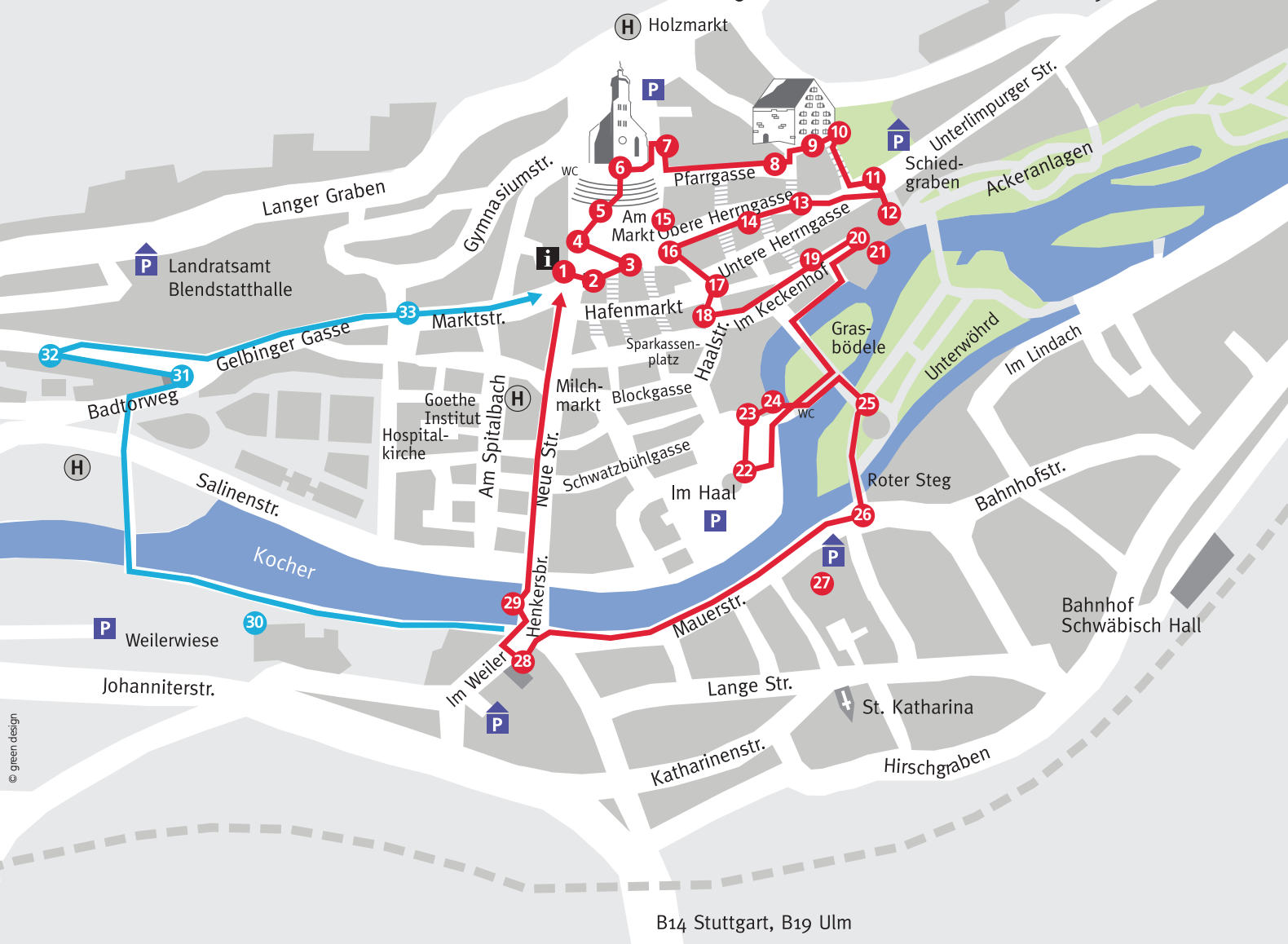 schwaebischhall.de
schwaebischhall.de
THE MARKTPLATZ
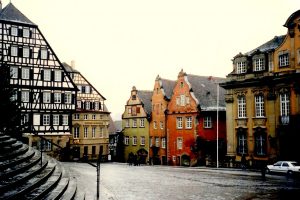 sandy robert
sandy robert
1 | Sibylla Egen House (The Nobleman’s Tavern)
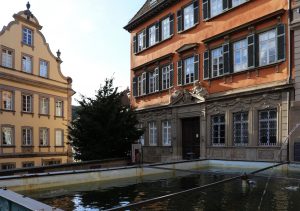 wikimedia commons
wikimedia commons
During the 16th century, the former Sibylla Egen House was once a tavern frequented exclusively by the nobility. This gorgeous home is located on the corner of Markt Square next to the Fountain and Pillory. Take in the views and grab coffee and dessert next door at Cafe Am Markt. ADDRESS: Am Markt 5, Schwäbisch Hall.
2 | The Commoner’s Tavern
 wikimedia commons
wikimedia commons
Built in 1510, this house was rebuilt in the Baroque style after a fire almost destroyed the entire city in 1728. Unlike the Egen Haus, this building was once housed a tavern reserved for common citizens. ADDRESS: Am Markt 7, Schwäbisch Hall.
3 | Rathaus (Town Hall)
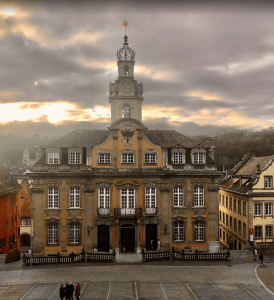 wikimedia commons
wikimedia commons
Erected as a Baroque palace in 1735, the town hall was built on the site of Jacob’s Church, which was destroyed in the great town fire of 1728. In 1945, the Town Hall was completely destroyed during the Allied bombing. It was rebuilt in 1955. Along the main square in front of the Rathaus are three strikingly beautiful orange and green colored Baroque homes. The centerpiece of the trio is the bright orange Widmanhaus. Next to the Widmanhaus, be sure to check out the Löwen-Apotheke (Lion Pharmacy). A pharmacy has existed here since the Baroque period. ADDRESS: Am Markt 6, Schwäbisch Hall.
4 | Fountain and Pillory
 wikimedia commons
wikimedia commons
In the central part of the Marktplatz is a peculiar sight, a Gothic fountain combined with a pillory. Since 1509, the fountain (a large iron tub) served as a fish tank of sorts for fresh fish sold at the market. Directly above the fountain is the pillory. In earlier times, prisoners would have their heads and hands exposed in the holes of this wooden framework. Here they would be publicly humiliated for their crimes and local townspeople would hurl vegetables at them. Needless to say, this approach was quite effective.
The pillory is accented with early 16th century sculptures of St. Michael, St. George, and St. Simson vanquishing demons. The Fountain and Pillory is steps away from the Goldener Adler, a beautiful half-timber framed home that has served as a guest house since the 16th century. One very cool feature of this guest house is its firewall. During the great fire of 1728, the firewall-protected the Goldener Adler and other buildings surrounding St. Michael’s Church. ADDRESS: Am Markt 10, Schwäbisch Hall.
ST. MICHAEL’S CHURCH + PFARRGASSE
5 | The Grand Steps
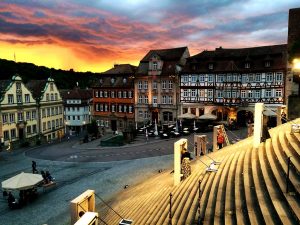 wikimedia commons
wikimedia commons
Leading from the Marktplatz to the church vestibule is the Freilicht Spiele — 54 majestic steps in a vast staircase that have been used as an open-air theater since 1925. Another 160 steps take visitors to the tower to the bell chambers and the former residence of the tower watchman. The staircase was constructed between 1507 and 1510. ADDRESS: Am Markt 1, Schwäbisch Hall, Germany.
6 | St. Michael’s Church
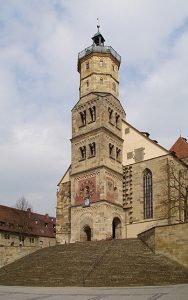 wikimedia commons
wikimedia commons
St. Michael’s Church stands majestically over the Marktplatz of Schwäbisch Hall. You can reach the church by using the various cobblestone streets that lead up the hill from the Kocher River. The church houses a remarkable collection of medieval wooden carvings. On the more macabre side, there is also a crypt with an ossuary containing neatly stacked piles of human bones. St. Michael’s Church was consecrated in 1156 as a Romanesque basilica. The Church would change throughout the centuries as architectural styles came and went. In 1427, the majority of the Romanesque basilica was demolished and the church was rebuilt in Gothic style with several additions being added between the 15th and 16th centuries. ADDRESS: Am Markt 1, Schwäbisch Hall, Germany.
Points of interest:
— St Michael’s Church contains 14 different representations of Michael the Archangel. An early Gothic depiction from 1290 shows the Archangel Michael as a dragon slayer. His wings are made of copper (originally they were made of gold). This statue of the Archangel Michael watched over the marketplace and over the town as the guardian of justice.
— Of interest, a new Gothic west tower was planned but was never built. Today, there are stone pieces protruding from the church’s facade that suggest where the tower would have been constructed.
— In 1456, builders constructed an arch (or vault) in the Gothic nave. The date of construction and the stonemason’s “maker’s mark” were painted on the vault. Common during the Middle Ages, a maker’s mark was a symbol or marking that stonemasons would use to identify an object as their work. In this case, stonemason Nikolaus Kief the Elder left his mark, the number 26, on the keystone on the last yoke of the south aisle on the west wall. Further, there is a 15th-century painting on plaster on the vault that shows a master builder in his stonemason guild outfit holding his equipment.
— In the 16th century, the townspeople unearthed a mammoth tusk near the nearby Buhler Valley. Since the field of paleontology did not exist at the time, it was thought that the mammoth tusk was actually a unicorn’s horn. Today, the tusk hangs on the wall in the ambulatory (the passageway behind the high altar) of St. Michael’s.
7 | Am Klosterbuckel
 wikimedia commons
wikimedia commons
After departing the church, circle around the church site to find the Am Klosterbuckel book store and the Pfarrgasse or priest’s alley. For centuries, this book store was a wine tavern. Without much effort, you should be able to see the old stone mounting step for horses in front of the house. Walking straight down Pfarrgasse until you reach the end of the alley. ADDRESS: Klosterstraße 9, Schwäbisch Hall.
8 | Johannes Brenz House
 wikimedia commons
wikimedia commons
This was the residence of Protestant Reformation leader Johannes Brenz, who was a contemporary of Martin Luther. In 1522, Brenz brought the Reformation to Schwabisch Hall. Continue to the left and walk up the staircase. Pass through the metal door to reach the “Swallow’s Nest” and the Neubau. ADDRESS: Pfarrgasse 18, Schwäbisch Hall.
9 | Swallow’s Nest
 wikimedia commons
wikimedia commons
This quiet spot affords panoramic views of the city. ADDRESS: Rosenbühl 14, Schwäbisch Hall.
OBERE HERRNGASSE
10 | The NeuBau
 wikimedia commons
wikimedia commons
Construction on the Neubau (new building) began in 1504 and was completed in 1533. The upper floors were used as a storehouse and granary. The ground floor was used as an armory. The staircase on the left leads down to the Schiedgraben Bridge. ADDRESS: Rosenbühl 14, Schwäbisch Hall.
11 | The Scheidgraben Bridge
 wikimedia commons
wikimedia commons
The Schiedgraben Bridge separated the Imperial Town from the property belonging to the Schenken family who hailed from Limpurg. Access to the Bridge was once protected by the Limpurg Gate. After a serious feud with the town, the Schenken family walled off the gate in 1431. The wall was removed in 1543 after the Schenken family sold their territory. Today, there is a modern bridge connecting the Imperial Town and the former estate of the Schenken family. ADDRESS: Unterlimpurger Strasse, Schwäbisch Hall.
12 | Salt Boiling Hut
Near the bridge is the salt boiling hut. During the glory days of Schwäbisch Hall’s salt production, large quantities of “white gold” were produced here. ADDRESS: Unterlimpurger Strasse, Schwäbisch Hall.
13 | Upper Gentleman’s Alley
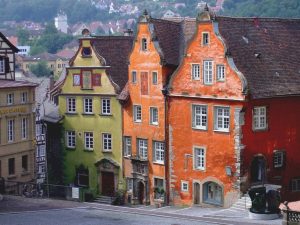 mapio.net
mapio.net
Obere Herrngasse is referred to as “gentlemen’s alley.” During medieval times, wagons of salt would be dispatched from Schwäbisch Hall to markets in the farthest corners of Central Europe. The salt trade was lucrative, incredibly lucrative. The homes of gentleman’s alley are a testament to this wealth. Although just a smattering of once existed, these palatial homes have five to six stories. The front doors are adorned with the family’s coat of arms. Incredibly, the wine cellars under these homes run several stories deep. Obere Hernngasse 11 is an interesting building. On the ground floor, which is sometimes accessible, the ceiling is painted with silver stars on a blue background. On the exterior, there are painted diamonds from the Renaissance period. ADDRESS: Obere Herngasse 11, Schwäbisch Hall.
14 | Architektenhaus
 wikimedia commons
wikimedia commons
From 1893 to 1938, the Architektenhaus (House of Architects) was a prayer hall for the Jewish community. ADDRESS: Obere Herrngasse 5, Schwäbisch Hall.
15 | Am Markt 2
 wikimedia commons
wikimedia commons
At one time, the half-timber framed house at Am Markt 2 played an important role in the town’s history. Am Markt 2 was one of the perimeters for deadly duels between knights held in the Marktplatz. In fact, chains were hung from the houses to cordon off the area so knights could publicly settle their disputes with swords and lances. Today, chain links can still be found along the walls of Am Markt 2. ADDRESS: Am Markt 2, Schwäbisch Hall.
16 | Franciscan Monastery
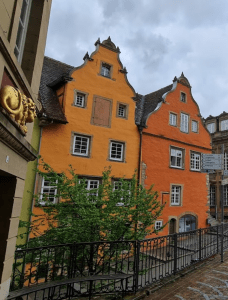 wikimedia commons
wikimedia commons
From 1236 to 1524, Jacob’s Church and the buildings at Stellwaghaus 4 and Widmanhaus 5 were used as a Franciscan monastery. Today, Stellwaghaus 4 is now home to a disco called the Barfuesser (the Barefooter). The name Barfuesser pays homage to the Franciscan monks who renounced the wearing of shoes. ADDRESS: Am Markt 4, Schwäbisch Hall.
17 | Olli’s Bar
 wikimedia commons
wikimedia commons
The half-timber framed house on the Hafenmarkt, today known as Olli’s Bar, is the oldest surviving half-timber framed house in Schwäbisch Hall. Completed in 1289, it is also one of the oldest houses in Germany. ADDRESS: Untere Herrngasse 2, Schwäbisch Hall.
18 | Sparkasse Bank
 sparkgasse-sha.de
sparkgasse-sha.de
In 1939, construction workers discovered a Celtic salt production site while laying the foundation of the Sparkasse Bank. The site included four wooden troughs and shards of clay from broken salt containers. The troughs were dated to 500 B.C. ADDRESS: Sparkassenplatz, Schwäbisch Hall.
19 | Keckenturm
 wikimedia commons
wikimedia commons
Eight stories tall with red shutters, this tower house was built from 1238 to 1239. The noble Keck family resided here from 1393 to 1545. ADDRESS: Keckenhof, Schwäbisch Hall.
THE HÄLLISCH FRÄNKISCHES MUSEUM
20 | Hällisch-Fränkisches Museum
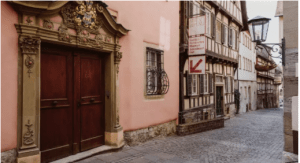 haellisch-fraenkisches-museum.de
haellisch-fraenkisches-museum.de
The Hällisch-Fränkisches Museum has a chronological exhibit that explains the artistic and cultural history of Schwäbisch Hall and the Württemberg-Franconia region. It also has a unique exhibit on the American occupation of Dolan Barracks following WW2. ADDRESS: Keckenhof 6, Schwäbisch Hall.
21 | Stadtmühle
The Stadtmühle, which is affiliated with the Hällisch-Fränkisches Museum, tells the story of Schwäbisch Hall during the 19th and 20th centuries. On display is a wooden synagogue panel from 1739. There is also an exhibit on the city’s tradition of salt making. According to legend, the simmerers saved the watermill and the miller’s family in 1316 by helping to extinguish a fire. In appreciation, the miller sent a 90-pound cake. This cake was decorated with a wreath and was carried in a ceremonial procession to the city fountains. This tradition lives on during the city’s three-day festival held annually on White Sunday. Depart the museum towards the river and stay to the right on Steinerner Steg. Take another right turn and cross over the covered wooden bridge towards the Haalplatz. ADDRESS: Keckenhof 6, Schwäbisch Hall.
HAALPLATZ
22 | Haalbrunnen
 wikimedia commons
wikimedia commons
Perhaps the town’s most coveted possession, brine was extracted from the Haalbrunner, a 13 meter (43 feet) deep well. Salters would boil the brine into “white gold” in salt pans in the Haal houses surrounding the square. Believe it not, the well remained in use from the middle ages until 1957. Brine is still extracted from the ground through a modern hole drilled in the same vicinity. Today, the brine is used for therapeutic purposes at the nearby Solebad Spa in the Hohenlohe Hotel. The descendants of the Salters are entitled to a pension in perpetuity. Merely a matter of prestige, Salter descendants receive EUR 1.50 (USD 1.60) from the State. ADDRESS: Im Haal 9, Schwäbisch Hall.
23 | Haalamt
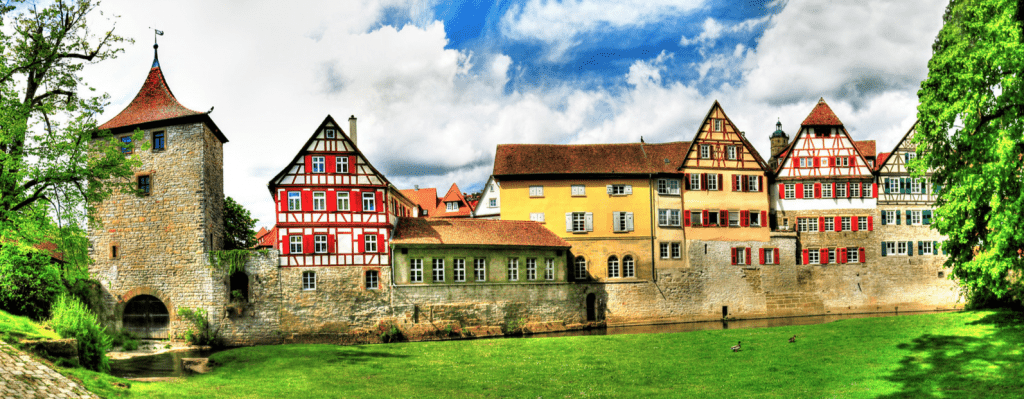 Daniel Mennerich
Daniel Mennerich
At one time, the Haalamt district of Schwäbisch Hall was the home of the town’s salt industry. This district is characterized by its green timber-framed buildings. Today, a Haalschreiber oversees the state pensions of the salt workers. ADDRESS: Im Haal 2, Schwäbisch Hall.
24 | The Sulferturm
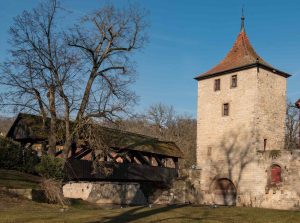 eutourdata.eu
eutourdata.eu
Since 1250, the Sulferturm (Sulfer Tower) has served as a prison. Although the foundation and lower sections of the Tower are original, the upper floors were rebuilt after the great fire of 1728. ADDRESS: Im Haal 2, Schwäbisch Hall.
25 | The New Globe Theater
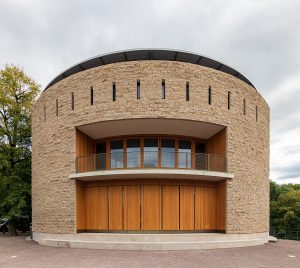 wikimedia commons
wikimedia commons
Schwäbisch Hall has its own version of Shakespeare’s Globe Theater. During the Summer months, the New Globe Theater hosts outdoor performances. ADDRESS: Unterwöhrd 1, Schwäbisch Hall.
26 | Katharinenvorstadt
To the south of the Old Town across the Kocher River is the Katharinenvorstadt neighborhood. Built in the 14th century, Katharinenvorstadt was home to the city’s artisans and craftsman and was a suburb of Schwäbisch Hall. ADDRESS: Maeurstrasse, Schwäbisch Hall.
27 | Kunsthalle Würth
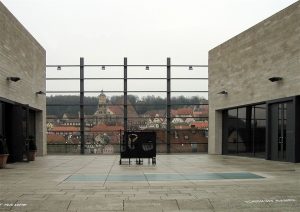 wikimedia commons
wikimedia commons
The Kunsthalle Würth is a major art museum containing over 11,000 works of art from the 20th century. Major works of art in the collection belonged to the Fürstenberg family. ADDRESS: Lange Strasse 35, Schwäbisch Hall.
29 | Henkersbruecke
 wikimedia commons
wikimedia commons
The original Henkersbruecke (executioner’s bridge) was a stone bridge built in 1502. The bridge was destroyed in 1945 during WW2 and was rebuilt in 1949. Continue west along the Kocher River to the Weilerstag. ADDRESS: Salinenstraße, Schwäbisch Hall.
THE WESTERN NEIGHBORHOODS
30 | Weilersteg
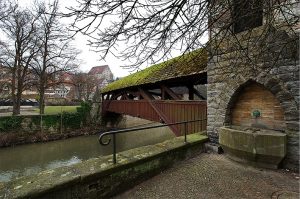 wikimedia commons
wikimedia commons
The Weilerstag is a covered wooden bridge that crosses the Kocher River. Cross the river and walk towards the square. Continue along Badtorweg to find a good view of the old prison. Continue on Badtorweg until you reach Gelbinger Gasse. Here you will find the Josenturm tower. ADDRESS: Weilersteg Covered Bridge, Schwäbisch Hall.
31 | Josenturm
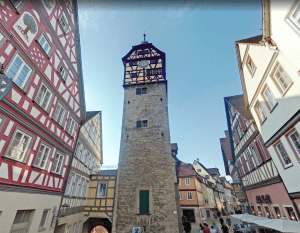 Google Maps 2022
Google Maps 2022
One of the city’s original towers, the Josenturm has protected the city since 1250. At one time in the early 13th century, it was the Chapel of St. Jodocus. Head back towards the Henkersbruecke (executioner’s bridge) until you reach the most beautiful home in Schwäbisch Hall, the Gräterhaus. ADDRESS: Gelbinger Gasse 32, Schwäbisch Hall.
32 | Gräterhaus
 wikimedia commons
wikimedia commons
The Gräterhaus has the distinction of being considered the most beautiful timber-framed building in Schwäbisch Hall. It was built by Rotgerber Hans Gräter in 1616. ADDRESS: Gelbinger Gasse 47, Schwäbisch Hall.
33 | Säumarkt and Malefiz Towers
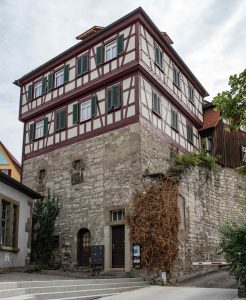
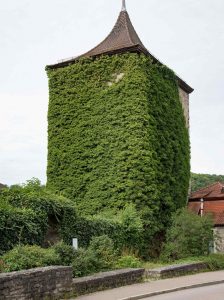 eutourdata.eu
eutourdata.eu
To the left of the Gräterhaus is the neoclassical Württemberg police station. Built in the early 1200s, the Säumarkt Tower “towers” above the police station. Nearby is the Malefiz Tower built in the 1100s. At one time, the Malefiz Tower was a jail. These two towers once guarded the northernmost approaches to the city. If you look closely, you can find a section of the original city wall between the two towers. ADDRESS: Am Säumarkt, Schwäbisch Hall.
OUR EXPERIENCE IN SCHWÄBISCH HALL
We had just departed Heidelberg and were in our Honda CRV traveling through Bavaria and Swabia. Always spontaneous, my wife took the opportunity to research some off the beaten path places we could visit en route. Rather serendipitously, she thumbed through our Lonely Planet travel guide for Germany and discovered a meager entry highlighting Schwäbisch Hall. Having no clue what to expect, I turned our SUV around in a farm field and we headed toward Schwäbisch Hall. After exiting from the highway and driving rather aimlessly through several quaint farming communities, we arrived in Schwäbisch Hall in the late afternoon and found parking along the Kocher River.
One look at the town and we knew it had to be explored. We quickly departed on foot — our son leading the charge across the Henkersbruecke (Henkers Bridge) and uphill to the Marktplatz and St. Michael’s Church. After taking a short break to recharge our batteries with a tasty cup of coffee and some scrumptious desserts at the Cafe Am Markt, we spent the next several hours exploring every nook and cranny of Schwäbisch Hall.
We quickly fell in love with this medieval town. Compared to other medieval towns in Germany, the most unique thing about Schwäbisch Hall is the sheer number of massive half-timber framed homes. Schwäbisch Hall must have the highest concentration of preserved seven and eight-story homes in Germany. They are truly impressive. You really get a sense of the wealth that existed in the middle ages and what an economic powerhouse the town must have been.
To really get your travel money’s worth, you really need to explore the whole town, not just stay along the river. The best parts of this medieval jewel are located beyond St. Michael’s Church. This means… you have to walk uphill. Although this can seem quite intimidating, it is well worth the walk and exercise. You will be rewarded with some incredible photographs. Schwäbisch Hall is the type of town where you really need to “get curious.”
Explore all of the various alleyways and get up close and personal with the half-timber framed homes. We were so happy we took the time to check out this amazing place and all experience the incredible things to see and do at your fingertips in Schwäbisch. As the old saying goes, if life gives you lemons, then make lemonade!
PRO TIPS AND OTHER THINGS TO DO WHEN VISITING SCHWÄBISCH HALL
PRO TIP 1 – VERY IMPORTANT. Parking is ample and available in any of the parking lots along the Kocher River. Once you depart your vehicle, you are on foot and walking mostly uphill. There is some parking in the town, but it is difficult to find available spots.
PRO TIP 2. – VERY IMPORTANT. To really experience Schwäbisch Hall, it is important put what you see into context. Digest our GUIDE TO THE BEST THINGS TO DO IN THE ALTSTADT (OLD TOWN) OF SCHWABISCH HALL before exploring on foot. Also, familiarize yourself with the map.
PRO TIP 3. – VERY IMPORTANT. If you are short on time, we suggest heading to the Marktplatz and then finding an alternate route through the maze of medieval alleys back to the Kocher River.
PRO TIP 4. Cafe Am Markt. For a hot cup of coffee and some homemade desserts, take a time out at the Cafe Am Markt. As the name implies, it is located on the corner of the Marktplatz and is literally a stone’s throw away from the action. Alternatively, the cafe makes for a great place to people-watch or gaze at the medieval architecture all around you. This magnificent Rococo house was built after the devastating city fire in 1728. With its rich facade, it is more reminiscent of noble seats than a simple townhouse. ADDRESS: Am Markt 10, 74523 Schwäbisch Hall.
PRO TIP 5. Schwäbisch Hall is available to explore any time, night or day. Pathways along the Kocher River are generally flat and smooth. In the historic town center, the cobblestone roads and stairs are typical of what you would find in most medieval towns. Although accessible, some alleyways can be uneven. Remember to always bring a backpack, some water, and some snacks.
PRO TIP 6. Do not be intimidated by the fact that Schwäbisch Hall is an uphill adventure. It is totally worth the walk. You can “pace yourself” and “find inspiration” at any one of the town’s cafes and taverns. Don’t just stay along the Kocher River or you will really miss out.
PRO TIP 7. Don’t shy away from climbing the Grand Steps of St. Michael’s Church and taking in views of the Marktplatz and the medieval homes.
PRO TIP 8. On Wednesday and Saturday mornings there is a weekly farmer’s market in the Marktplatz. The islands and riverbanks of the lower town are great for picnics.
PRO TIP 9. Bring a camera and be prepared to be overwhelmed with a world of massive majestic half-timber framed homes.
OTHER COOL THINGS TO DO NEAR SCHWABISCH HALL
OLD LÖWENBRAU BREWERY. Interested in a brewery tour and tasting? Look no further. Haller Löwenbräu offers tours of their brewery complete with tasting, food, and a souvenir beer glass. For tours in English contact [email protected]. ADDRESS: Ritterstraße 6, Schwäbisch Hall.
HOHENLOHE OPEN AIR MUSEUM. Located 10 minutes by car from the Old Town in the scenic expanse of the Hohenlohe plain (Hohenlohe Ebene), the museum has 70 carefully selected historical buildings from various villages and towns all over the Franconian portion of Württemberg. Each building was painstakingly transported to the museum site and furnished with authentic period pieces. Among the buildings open to visitors are farmhouses, tradesmen homes, workshops, barns, mills, a chapel, and a jailhouse. ADDRESS: Dorfstraße 53, 74523 Schwäbisch Hall.
GROSSCOMBURG MONASTERY. Großcomburg in Schwäbisch Hall, a former Benedictine monastery, was founded in the year 1078. Today Großcomburg’s grounds are open to the public, and the 420-m-long walkway around the perimeter affords wonderful views over the town of Schwäbisch Hall and the Einkorn viewpoint (510 m high). ADDRESS: Comburg 5, Schwäbisch Hall.
DOLAN BARRACKS. For WW2 veterans and history buffs, there are two excellent museum displays concerning Dolan Barracks, the former WW2 Luftwaffe Airbase that housed the Messerschmitt Me 262 the world’s first fighter jet. These revolutionary machines were assembled in a nearby camouflaged facility that was decimated by the Allies in February 1945. Hitler would only agree to mass-produce the Me 262 with the condition that the aircraft should primarily be used as a bomber. The Me 262 was nicknamed the “flash bomber” or ” lightning bomber.” This strategy would prove disastrous since the plane was designed to be an interceptor not a high speed bomber. In fact, the Nazis had a serious advantage over the Allies as the Me 262 could outfly any known propellor driven airplane at the time. As a bomber, the Me 262 lost its advantage of speed. Furthermore, the pilot had a limited view of the ground from the cockpit. Attempts to persuade Hitler to give priority to the interceptor version failed and as they say, the rest is history.
FLUGPLATZ MUSEUM. Located at the Schwäbisch Hall-Hessental Airfield, the Flugplatz Museum has exhibits focused on the early development of the German Air Base and the presence of the U.S. Army. The extensive display includes parts of German aircraft excavated from the airfield. The Museum is housed in the Haus der Wirtschaft (House of the Economy), the building located directly to the right of a large WW2 era hanger.
NEAR THIS PLACE
TRAVEL GUIDE | ROTHENBURG OB DER TAUBER. Rothenburg, a fairytale Bohemian town of gingerbread buildings surrounded by an impressive medieval wall located along Germany’s Romantic Road.
TRAVEL GUIDE | BAMBERG. A UNESCO World Heritage Site, Bamberg is a medieval jewel with an impressive Altes Rathaus (Old Town Hall), and a network of bridges and Old Town.
TRAVEL GUIDE | NAZI PARTY RALLY GROUNDS. The Nazi Party Rally Grounds in Nuremberg, a deserted Zeppelin airfield, the unfinished Congress Hall, and other structures that once hosted one of history’s most evil man and his devoted followers.
TRAVEL GUIDE | NUREMBERG PALACE OF JUSTICE. Evil was on trial in courtroom 600 of the Nuremberg Palace of Justice.
TRAVEL GUIDE | REGENSBURG. A UNESCO World Heritage Site, Regensburg has the largest preserved medieval old town north of the Alps. Regensburg also has several fine Roman exhibits.
TRAVEL GUIDE | LIMBURG AN DER LAHN. The oldest house in German and the House of Deadly Sins are just a few things to see and do in the preserved town of Limburg an der Lahn.
BEST PLACES TO STAY
GASTHOF GOLDENER ADLER. Located in a 15th-century building, Gasthof Goldener Adler is right on the market square in Schwäbisch Hall’s Old Town District. Classic style rooms with FREE Wifi, a bottle of water, and a plate of fruit provided upon arrival. Bike rental service available. ADDRESS: Am Markt 11, Schwäbisch Hall, Germany.
REBERS PFLUG. Built in 1805, this historic family-run guesthouse is located in a quiet location only 10-minutes from the town center. Elegant rooms, an award-winning restaurant, summer terrace, wine cellar, and FREE parking. All rooms and suites are non-smoking with FREE Wi-Fi. ADDRESS: Weckriedener Strasse 2, Schwäbisch Hall, Germany.
HOTEL SCHOLL. Located next to St. Michael’s Church in the Old Town district of Schwäbisch Hall, this hotel offers modern accommodation and FREE WiFi and a fitness area. Each room is unique. The granite bathrooms are handmade by Italian artisans. In the morning the juice and barista coffee bar has fresh juices made to order and fresh French croissants and pain au chocolat. ADDRESS: Klosterstrasse 2-4, Schwäbisch Hall, Germany.
PANORAMAHOTEL WALDENBERG. 20 minutes from the Old Town, Panoramahotel Waldenburg has air-conditioned rooms, a restaurant, bar and fitness center, FREE WiFi, and sauna. ADDRESS: Haupstraße 86, Waldenburg, Germany.
![]()



